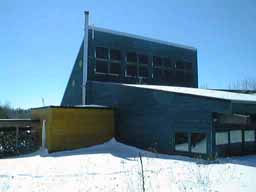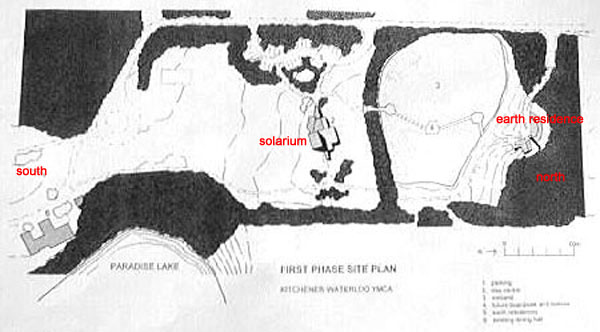
Sustainable
Architecture Case Study:
Greenhouse As Energy Source
SOLARIUM: YMCA Environmental
Learning Center
Conference Room/Greenhouse Building
(Paradise Lake), Waterloo, Ontario, Canada
 |
Sustainable
Architecture Case Study: SOLARIUM: YMCA Environmental
Learning Center (Paradise Lake), Waterloo, Ontario, Canada |
Student Research Team:
Trevor McIvor, Pablo Leppe, Peter Marshall, Donald Peters, Lachlan Oddie
(This study was originally submitted by the students in 1998 as part of the Vital Signs Student Case Study Competition as an Adobe Pagemaker 6.0 file. This version is a current rework of the information in web format. The content is as originally written.)
BACKGROUND:
A study of the effectiveness of a greenhouse as a source of energy for an entire building, focusing on the distribution of heat throughout the rest of the building, and stabilization of room temperatures throughout, not only in terms of human comfort, but in terms of sustainability of plant and animal life for the purposes of consumption. The study takes place in late winter during especially warm weather and is an extreme example of dramatic weather shifts that an automated building such as this must contend with.

Site Plan: Solarium Building at center, south is to the left
The building was not functioning under proposed design situations, namely that there was no plant life in the sunroom, and that the subfloor of the building did not hold a hydroponic pool. These energy absorbing elements would dramatically reduce the temperature levels throughout the building, acting as trombe masses and better retaining temperature. It was found that the temperature levels in the room were exceedingly high in the winter, and that without more mass would be unbearable in the summer. Also, for the building to act as an educational instrument the plant life must be present, so as to illustrate the concept of sustainability. Certainly the design was successful in that the building was a comfortable temperature in the winter while not being heated other than from the sunroom.
![]()
![]()
![]()
![]()